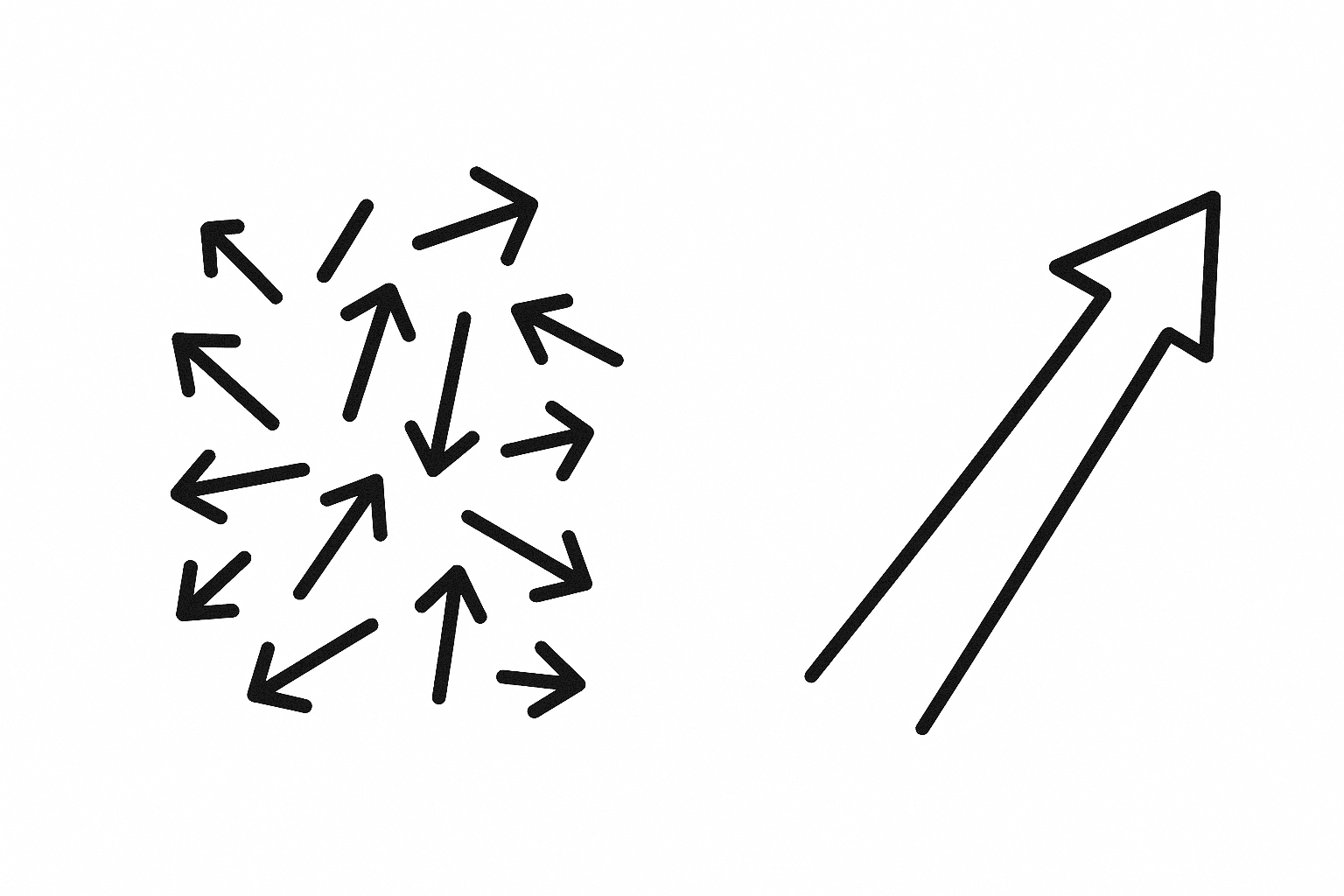Changing organizational direction is like turning a massive ship. The larger the organization, the more this metaphor holds true.

You can’t just yank the wheel and expect immediate results. The momentum of the existing direction carries the organization forward, resisting change.
I wrote about why direction matters more than speed in organizational momentum. But knowing where you want to go is different from actually getting there. I’ve seen this pattern enough times to know where people give up and where they push through.
Whether you’re an executive, a team lead, or an individual contributor trying to drive change—the dynamics are the same. You’re working against existing momentum, and that takes sustained effort regardless of your title.
Many Small Pushes
Change happens through many small pushes, not one dramatic shift.
Each decision, each meeting, each communication that aligns with the new direction adds a small force vector. Initially, these forces seem insignificant against the massive momentum of the current direction.
But not all pushes are equal. The key is finding the levers that make the biggest difference. Some decisions cascade through the organization—who gets hired, what gets measured, which projects get funded, how teams are structured. These aren’t just small pushes; they’re force multipliers that touch everything downstream.
I’ve learned to look for these leverage points early. Where does attention naturally flow? What decisions do people watch to understand what actually matters? Those are your levers. Push there, and the effect compounds far beyond the immediate action.
Your levers look different depending on your position. An executive controls funding and structure. A team lead influences what gets celebrated and who gets hired. An individual contributor shapes technical direction through code reviews and architecture proposals. But the principle is the same: find where small actions create outsized impact.
Momentum is cumulative. Over time, these small pushes—especially the ones applied to the right levers—begin to add up. The ship starts to turn, slowly at first, then with increasing speed.
The Resistance Phase
The most challenging period is the early phase, when you’re pushing against existing momentum. This is when change initiatives often fail—leaders give up because they don’t see immediate results. They expect the ship to turn on a dime, and when it doesn’t, they conclude the effort is futile.
But this is exactly when persistence matters most. The resistance you’re feeling is the organization’s existing momentum pushing back. It’s not a sign that change is impossible—it’s a sign that you’re pushing against something real.
Every decision is questioned. The old ways keep reasserting themselves. Progress is invisible or easily reversed. You’re constantly explaining the same things. Exhaustion sets in for change leaders.
This is normal. This is the physics of organizational change.
The Tipping Point
There comes a moment when the cumulative effect of all those small pushes reaches a tipping point. The ship’s direction is changing, even if it’s barely perceptible at first. This is when the change becomes self-reinforcing, when the organization’s own momentum starts working in your favor.
At this point, something remarkable happens: the change becomes unstoppable.
The organization begins to generate its own momentum in the new direction. People start making decisions that align with the new direction without being told. The culture begins to shift naturally. New hires come in and assume this is just “how we do things here.”
When to Ease Off
Here’s the counterintuitive insight: once the ship is turning, you need to ease off.
Just as it took sustained effort to start the turn, it will take sustained effort to stop it. The momentum that was working against you is now working for you. The change itself becomes inevitable.
This is why over-correction is a real danger. I’ve seen leaders who fought hard to initiate change not realize when the battle is won. They keep pushing with the same intensity, and the organization overcorrects, swinging too far in the new direction.
The art of organizational change is knowing when to push hard and when to guide gently. Early on, you push. Once momentum shifts, you steer.
Why Change Feels Inevitable in Retrospect
Early-stage change feels difficult. Successful change feels inevitable in retrospect. The work you do in the resistance phase creates the foundation for the acceleration phase.
People who join after the tipping point can’t imagine the organization any other way. They wonder what the big deal was. “Of course we do it this way,” they say.
What This Means for You
If you’re driving change—at any level—start by identifying your levers. Where can you apply force that creates the biggest impact? This looks different depending on your position, but the principle is the same: find the decisions and actions that cascade.
Commit to sustained effort during the resistance phase. Don’t expect immediate results. Celebrate small wins that align with the new direction. Keep communicating the why, relentlessly. Build a coalition of people pulling in the same direction.
After the tipping point, recognize when momentum has shifted. Ease off the intensity of your push. Guide rather than force. Watch for overcorrection. Let the organization’s own momentum do the work.
Organizations that succeed in transformation understand they’re playing a long game. They know that turning a ship takes time, that resistance is normal, and that once the turn begins in earnest, it becomes self-reinforcing.
Patience during the resistance phase. Recognition when the tipping point arrives. That’s how you turn the ship.

